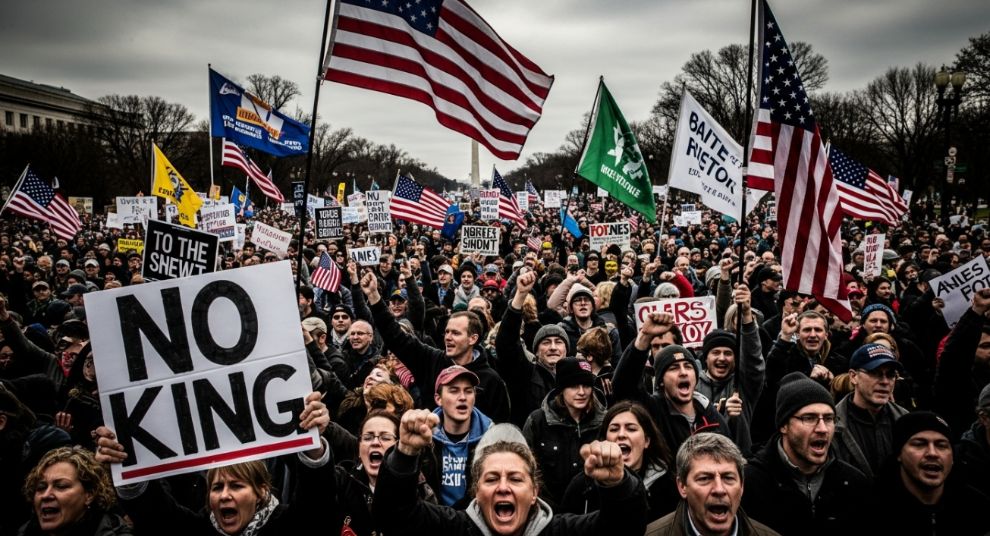The government doors are tightly shut, and crowds are pouring into the streets—a political storm is quietly reshaping the future of the economy.
In October, the United States is shrouded in political tension. The federal government shutdown has entered its third week, and the deadlock on Capitol Hill remains unresolved; meanwhile, millions have taken to the streets, holding up signs reading “No Kings” to protest President Trump’s “monarchical rule.”
Behind these political events, which may seem unrelated to ordinary investors, a far-reaching market transformation is brewing—especially for the emerging field of cryptocurrency.

01 Political Deadlock: Shutdown Crisis and Street Protests
The U.S. government shutdown has lasted for over half a month. As of October 17, the Senate has held its tenth vote on a temporary funding bill, but it still has not passed. This deadlock is heading toward becoming the second-longest government shutdown in U.S. history.
Treasury Secretary Besant has issued a warning: the ongoing government “shutdown” is causing about $1.5 billion in economic losses for the U.S. every day.
More seriously, the shutdown has delayed the release of key economic data, including the highly watched Consumer Price Index (CPI) and employment reports. Federal Reserve Chair Powell expressed concern, noting, “If the ‘shutdown’ lasts for a while, they will be unable to collect data, and the situation will become even more challenging.”
Meanwhile, from October 18 to 19, the U.S. saw large-scale “No Kings” protests. Organizers claimed that more than 2,600 demonstrations were held across all 50 states.

In New York, although over 100,000 people participated, there were no protest-related arrests.
These demonstrations directly targeted President Trump’s policies and leadership style. Senator Bernie Sanders stated bluntly at a rally: “No, President Trump, we do not want you or any other king to rule us.”
02 Economic Impact: From Data Gaps to Global Concerns
The most direct impact of the government shutdown is the “cut-off” of economic data. The Department of Labor has postponed the release of the September Consumer Price Index report, and previous employment data was also delayed. This data blackout not only affects domestic decision-making but also has a ripple effect on the global economy.
Reuters has warned that “a U.S. data blackout is casting a shadow over the globe,” as many countries typically use U.S. data to assess the trajectory of the world’s largest economy.
Bank of England Monetary Policy Committee member Catherine Mann pointed out that this situation could weaken the dollar’s status or erode the Fed’s independence, likening it to “termites slowly eating away at the foundation.”
S&P Global Market Intelligence estimates that if the U.S. government shutdown continues, the unemployment rate could rise sharply from 4.3% to 4.8%.
The White House Council of Economic Advisers predicts that a one-month government shutdown could result in a $30 billion loss in consumer spending nationwide.
Data Indicator | Original Release Date | Shutdown Impact | Market Expectation | Impact on the Fed |
September Nonfarm Payrolls | October 3 | Completely delayed | 50,000 new jobs, 4.3% unemployment rate | Lack of employment signals, possible delay in rate cuts |
September CPI | October 15 | Completely delayed | Core CPI YoY 2.5%-2.7% | Inflation data deviation, increased policy uncertainty |
October FOMC Meeting | October 30 | Indirect impact | Hold or cut rates by 25bp | Highly dependent on NFP/CPI, likely to remain on hold |
Source: AiCoin compilation
03 Crypto Market: Short-term Volatility and Long-term Opportunities
Amid rising political and economic uncertainty, the cryptocurrency market has shown complex trends. The Fed’s monetary policy stance has become the most critical factor affecting the crypto market. Fed Chair Powell’s recent “dovish” remarks clearly signaled a rate cut, stating that the federal funds rate is expected to gradually decline.
This policy shift could inject strong momentum into the crypto market. Historical data shows that after the rate cut in 2024, bitcoin rose 30% as positive sentiment spread. As a typical high-risk asset, bitcoin and U.S. dollar fixed-income assets exhibit a “seesaw effect” with capital flows—during a rate-cut cycle, yields on dollar-denominated bonds fall, and capital tends to flow into the crypto market, pushing up coin values.
However, in the short term, the crypto market still faces multiple challenges. The scale of spot bitcoin ETFs has exceeded $60 billion, with continued institutional inflows serving as the core support for the market. But high-leverage trading by retail investors still triggers short-term volatility, with leveraged liquidations reaching $275 million in just 24 hours.
04 Market Outlook: Liquidity-Driven and Regulatory Constraints
Looking ahead, the trajectory of the crypto market will depend on the dynamic balance of three major factors: the pace of policy implementation, the sustainability of capital inflows, and constraints from sentiment and technicals.
● The regulatory environment is also changing. The EU Mac supplementary amendment has raised entry thresholds for small and medium institutions, and the U.S. ICC also plans to introduce derivatives regulatory rules.
● Increasing global regulation is pushing crypto asset valuation from a single liquidity-driven model to a multi-dimensional pricing model of “liquidity + policy factors.”
● On the other hand, the Fed’s balance sheet has dropped to $6.7 trillion, the lowest since April 2020, and ongoing quantitative tightening could lead to reduced market liquidity and increased volatility for major coins like bitcoin and ethereum.
05 Investment Strategy: Seeking Balance Amid Uncertainty
● In the face of political deadlock and market uncertainty, investors need to adopt more cautious strategies. The duration and resolution of the U.S. government shutdown will be key factors affecting short-term market trends.
If the shutdown continues, it will lead to further delays in economic data releases, making Fed policy decisions more difficult and possibly accelerating rate cut decisions.
● For the crypto market, the $115,000 level will become the next key resistance for bitcoin. Investors should closely monitor changes in corporate holdings and ETF inflows. Historical data shows that the strength of the institutional “buy and hold” consensus directly determines the height of the bull market.
● Against the backdrop of intensifying political polarization in the U.S., the “No Kings” movement may not be a one-off event, but could evolve into ongoing protests.
● The three major factors—pace of policy implementation, sustainability of capital inflows, and constraints from sentiment and technicals—will jointly determine the future direction of the crypto market.
